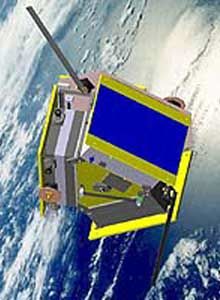
Home - Search - Browse - Alphabetic Index: 0- 1- 2- 3- 4- 5- 6- 7- 8- 9
A- B- C- D- E- F- G- H- I- J- K- L- M- N- O- P- Q- R- S- T- U- V- W- X- Y- Z
SSTL-10
 Snap Credit: Surrey |
AKA: Nanosat SSTL;SNAP. Status: Operational 2000. First Launch: 2000-06-28. Last Launch: 2000-06-28. Number: 1 . Payload: 4.00 kg (8.80 lb). Gross mass: 12 kg (26 lb).
With rapid advances in electronics and micro-electromechanical systems (MEMS), nanosatellites can execute sophisticated and important missions. SSTL and the University of Surrey's academic team developed the Surrey Nanosatellite Applications Platform (SNAP) as a practical platform for this new missions.
SNAP supported missions of 6 to 12 kg total mass with payloads of up to 4 kg. Yet within this small package, SSTL offered propulsion, attitude determination and control, on-board computing and communications options typical of larger missions.
The structure of SNAP was provided by three sets of modular electronic housings ('NanoTrays') formed around a triangular central bay. This central bay could host attitude actuators, propulsion units or payloads.
Equipped with GPS orbit determination, three-axis attitude control and a micro propulsion system, the SNAP platform was tailored to constellation and swarm missions that demanded dozens of inexpensive, yet capable, satellites.
SSTL launched the first SNAP platform, SNAP-1 in 2000, demonstrating the SNAP concept on a successful remote-inspection and formation flying mission.
Family: Sun synchronous orbit, Technology, Technology satellite. Country: UK. Launch Vehicles: R-14, Kosmos 3, Kosmos 11K65M. Launch Sites: Plesetsk, Plesetsk LC132/1. Agency: Surrey. Bibliography: 2, 552, 554.
 | SSTL Nanosatellite Credit: NASA |
 | SNaP Credit: Manufacturer Image |
 | SNAP 1 Credit: Manufacturer Image |
2000 June 28 - . 10:37 GMT - . Launch Site: Plesetsk. Launch Complex: Plesetsk LC132/1. LV Family: R-14. Launch Vehicle: Kosmos 11K65M.
- SNAP 1 - .
Mass: 6.00 kg (13.20 lb). Nation: UK.
Agency: Surrey.
Manufacturer: Surrey.
Class: Technology.
Type: Navigation technology satellite. Spacecraft: SSTL-10.
USAF Sat Cat: 26386 . COSPAR: 2000-033C. Apogee: 710 km (441 mi). Perigee: 691 km (429 mi). Inclination: 98.14 deg. Period: 98.70 min.
The SNAP-1 Surrey Nanosatellite Applications Platform was a 6 kg satellite with imager and propulsion. It was to test rendezvous techniques by formation flying with the Tsinghua satellite placed in orbit on the same launch. In October 2000 Surrey Satellite Technology Ltd (SSTL) released a picture of Tsinghua-1 taken in orbit by the SNAP-1 6.5 kg nanosatellite.
Back to top of page
Home - Search - Browse - Alphabetic Index: 0- 1- 2- 3- 4- 5- 6- 7- 8- 9
A- B- C- D- E- F- G- H- I- J- K- L- M- N- O- P- Q- R- S- T- U- V- W- X- Y- Z
© 1997-2019 Mark Wade - Contact
© / Conditions for Use